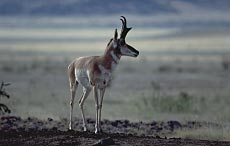Trans-Pecos West Texas Habitat Wildlife Management Pronghorn Antelope
The Chihuahuan Desert, the second largest desert in North America, is one of the most biologically rich and diverse desert ecoregions in the world. One of the large mammals that inhabit this area is the pronghorn antelope.

Pronghorn antelope.
Found only in North American, antelope are aesthetically popular and highly valued as a big game animal by hunters.
Currently, pronghorn antelope occupy approximately 14 million acres in the Trans-Pecos, High Plans, Rolling Plains, and Edwards Plateau Ecological Regions with about 70 percent occurring in the Trans-Pecos region. Population levels in the Trans-Pecos from 1978 to 2000 have changed significantly from a high of 17,000 animals in the mid-to-late 80s to a low of 5,200 animals in year 2000.
Because antelope live in sensitive habitats, TPW regulates harvest through hunt permits to provide maximum sustained yield without deleterious effects on the resource. Issuance of antelope hunt permits has paralleled the population decline through time, and it is the reduction of these hunt permits that have caught the attention of the hunting public. Hunters generally view a reduction of hunt permits for any species as "clouds upon the horizon" and want to understand the problem(s) that have affected (their) recreational opportunities.
In general, one could say the 'hand of man' and climatic factors are the cause. Specifically however, combinations of factors are responsible for the gradual decline of antelope numbers in West Texas. It is the cumulative factor effects through time that resulted in lower antelope numbers and hunt permits. And it is the same factors that will prevent an accelerated recovery if changes do not occur and rain does not come.
There is little question that severe die-offs occur periodically from malnutrition brought on by extended drought and by rainfall deficiencies during the late summer and early fall months. Pathology results of late winter antelope carcass samples sent to the veterinary pathology lab at Texas A&M University in the 1990's indicated malnutrition to be the cause of death.
Timely and adequate rainfall remains an integral element in maintaining the vitality and viability of antelope populations. There is a strong indication in the Trans-Pecos of a direct relationship between the rainfall received during the late summer and early fall months and survival over the winter and early spring. The most stressful period of the year for antelope is February and March because of the lack of adequate forage. Insufficient rainfall also translates to insufficient fawning cover in late spring and early summer. Twelve to 18 inches of herbaceous vegetation is required to adequately hide fawns from predators.
Net wire fences, a legacy of past large scale grazing of sheep and goats, continues to present a serious problem to the free movement of pronghorns in the Trans-Pecos. Barriers that restrict access or free movement from summer mixed prairie range to the rolling and rougher country which provides protection from inclement weather, additional food (browse & forbs), and often serves as fawning areas contribute to losses of antelope.
Antelope do not know they have the ability to jump net wire fences. Therefore, when food is inadequate resulting from improper livestock grazing and/or persistent drought, antelope rarely jump net wire fences in attempts to find food like mule deer. Antelope sometime get caught in fences attempting to access suitable forage, cover, or sanctuary. Rarely do antelope that have found access to forage in highway right-of-ways, survive today's traffic.
An antelope's primary means of defense against predators are their vision and speed. While fencing is a major tool for the management of livestock, additions of internal fences or establishing new ranch boundaries because a ranch has been sub-divided will result in fewer antelope. Coyotes haze antelope toward fences and catch them as they slow to crawl under the barrier or haze them toward corners where fast movement is restricted. The smaller the pasture the better the chances a coyote has for removing an antelope from the herd.
Predation by coyotes on antelope fawns and some adults appears to be a limiting factor in antelope production and survival throughout the Trans-Pecos area. The most critical period for antelope fawns is their first two months of life. Antelope fawning normally occurs May through July. If fawns can survive from birth to 60 days, then their chances of being added into the population increases dramatically.
Persistent dry cycles and/or effects of livestock grazing during drought on antelope fawning cover affects their survival. Since the late 80's, fawning cover has been very limited in the Trans-Pecos. Predators detect movement to locate prey. Without herbaceous cover, a significant number of fawns annually fall prey to coyotes within 30 days of birth. Low antelope fawn survival results in few replacement animals to antelope herds, and will suppress population growth. Low population growth directly affects the number of hunting permits available to qualifying landowners.